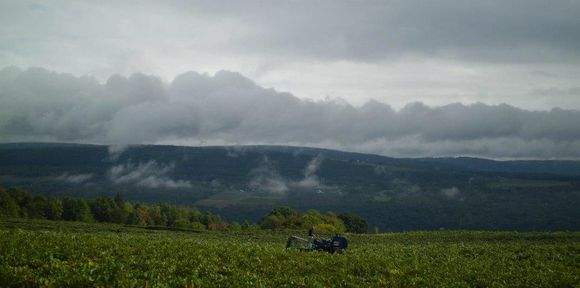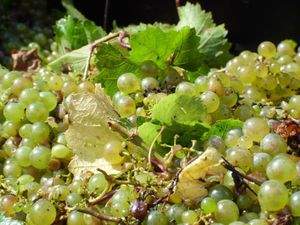
By Evan Dawson, Finger Lakes Editor
Photos courtesy Lakewood Vineyards. Above: Vineyard Manager Dave Stamp rides the harvester on a gloomy harvest day. Below: Early October riesling grapes at Lakewood showed clean fruit with occasional affected berries
Up and down Seneca Lake, no one was sleeping. No one was going home. After weeks of slowly building rot among the vines, the rains departed and the sun had gloriously returned. It was the 10th day of October, and this was the window, the chance, the opportunity to do the work and pull the 2011 vintage out of the fires of rot and disease pressure.
"Two months," one grower said to me, asking me not to use his name. "We basically did two months of work in eight days. Never seen anything like it."
At Billsboro Winery, Kim Aliperti kept the tasting room humming while rarely seeing her husband, winemaker Vinny Aliperti of both Billsboro and Atwater Estate Vineyards. Down at Lakewood Vineyards, the Stamp brothers looked like ragged warriors in their harvest beards. At Hermann J. Wiemer, winemaker Fred Merwarth and his wife Maressa welcomed their first child — a healthy boy — during a marathon session on the sorting line. (Fred and Maressa left the line to go to the hospital, but were back to work before the week was out.) Their colleagues made hot soup at midnight in between sorting sessions.
"We did things in the vineyard we'd never done before," said Oskar Bynke, a partner and marketing director at Hermann J. Wiemer. That's no surprise; the very best wineries adapt to the toughest tasks. More on their decision-making in a moment; the good news is that weather does not have the only say in wine. First, though, an explanation for what has made 2011 a grower's challenge.
Cold, then wet, then scorching, then wet
April and May were cold and wet - much moreso than normal. That got development off to a slow start, and yet fruit set was generally healthy and strong, and coming off a stunningly good vintage in 2010, that led to larger-than-normal crop sizes.
Keep that in mind, because those crop sizes are about to start dropping.
By June, growers were begging for dry weather. They enjoyed a solid month, warm and sunny. Then, it became too much of a good thing. July was scorching, with one stretch of five straight days seeing 95 degrees or above, with no rain. The ground, once saturated, cracked and hissed. Some vineyards saw vines begin to shut down; heat is generally good, but over 90 degrees, vines desperately need water. Those vineyards were beginning to exhaust what they had gained just weeks earlier.
When the rains finally returned, they came hard. "It seems like we never got just a quarter inch," that same grower told me, still asking to have his name withheld. "Who wants to be quoted on the record? We'd have to tell you the weather sucked, or we could sort of massage it. But every time it rained, it poured, and you can't take too much of that without getting trouble in the fruit."
He's talking about rot. Specifically, he's talking about botrytis. Some grapes turned sour, but most that were affected simply shriveled and turned raisiny. In small quantities, this can make for rich, sweeter rieslings, but most varieties do not want botrytis.
The first window to get the grapes in came with a burst of sunny, dry days in late September. Pinot comes first, and pinot vineyards were varied. Some lost fully half their crop to rot; others, like Chris Verrill's vineyard on the east side of Seneca Lake, saw pristine fruit. That's because Verrill has an irrigation system that allows him to keep the vines fed during brutal stretches of heat like the region saw in July. Consequently, those vines are better suited for rough patches closer to harvest.
The regional focus, of course, is on riesling. That would come later, during the second window, the one that will be remembered as the one that saved the riesling. Or, more accurately, as the one that gave growers a chance to save it, if they made the vital adjustments.
Some perspective from Cornell
Cornell has become a strong partner for growers, and Cornell's staff saw the struggles. But for Peter Landre, the executive director of Cornell Cooperative Extension of Yates County, the challenges in the Finger Lakes paled in comparison to what he was hearing in other parts of the state.
"I talk to farmers here, grape growers who say it's been a tough year," Landre said. "It has. But they've handled it. When we talk to our friends to the east, where the hurricane and tropical storm rains came through, it's devastation. You end up having a perspective."
And then there was that matter of fruit set. The larger-than-normal crop started to suffer, but because most growers started out with a big crop, some wineries will produce nearly as many cases of wine as last year. Some will produce quite a bit less. No one was totally wiped out.
One example of adaptation: How Wiemer made it work
When the second window of warm, dry weather opened, growers needed some time to dry out the fruit. Over a span of just about a week and a half, many wineries had to bring in riesling alongside red varieties like cabernet franc.
At Hermann J. Wiemer, vineyard crews routinely pick in three different passes: once early in the harvest season, preserving acidity; a second time within a week or two; and a final time to achieve the riper, richer flavors and more complexity.
But they had never picked three times in a single day.
"Give Fred credit," Bynke said, referring to winemaker and owner Fred Merwarth. "He knew we had to find another way. So we hand-picked the botrytis first. Then we went back out and picked the best clean fruit. Finally we followed with machines to pick the rest of the riesling. All in one day."
The result has the potential to be remarkable for the vintage: Hermann J. Wiemer has entire tanks of riesling that are free of botrysized fruit. There are also tanks with almost entirely affected juice, and that will give Merwarth options.
"We were fueled by caffeine, but that was the opportunity," Bynke said. "Last year everyone had options. This year, everyone had to figure out a different way."
What consumers need to know
The good news for consumers is that more wineries than ever before used sorting lines to hand-select the fruit. That's because there was so much rot, so much compromised fruit, that old techniques would generally not be enough. Some growers will say that they "sort in the vineyard," which makes a hand-sorting line unnecessary. Generally speaking, industry professionals report that this won't be enough in 2011 to produce excellent wine. General filtering and fining won't be enough to handle rot-affected juice.
What does that mean for consumers? Almost certainly, there will be more sub-standard wines than normal. There will be some bad wines, sure; some wineries are making few adaptations. But based on a wide range of reports, the regional approach has shifted to handle the weather and disease pressure. Growers adjusted spray schedules. The good wines will be worth celebrating, and there will indeed be very good wines. Consumers should not be afraid to ask a simple question in the tasting room, when the 2011 wines are for sale: Did you hand-sort the fruit that year? Or, how did you adapt to the challenging vintage?
Many wineries will have riveting stories to share.
On Cayuga Lake, Sheldrake Point's Bob Madill described a scene of rigorous sorting, both in the vineyard and on the crush pad. And he said that Sheldrake Point is making other adjustments. "We are going to be a bit minimalist in chaptalization and leave the alcohol levels a bit lower," he said. "If the weight of the fruit is on the lower side, then a low alcohol is more likely to yield a balanced wine." Madill predicted that the sorting and the other decisions will lead to "wines that are much better than what one might think. Certainly a year to avoid extraction and go for delicacy and balance."
When I finally reached Merwarth by phone Tuesday morning, it was 9am and he was clearly woken up by my call. He had gotten to bed at 6am, when the previous day's work ended. By Tuesday night he did not remember our conversation. His son will turn 21 during the harvest of 2032. It will be fascinating to open a Wiemer 2011 Riesling more than two decades from now. It will tell the stories, it will remember this manic harvest, even if Merwarth doesn't.
EDITORS NOTE: Some readers have asked about the description of the vintage as "challenging," which is the word we initially used in the title. It's not at all the same as referring to a vintage as "bad." When we use the term "challenging" or "demanding," it refers to the amount of work required to produce something excellent. In 2011, the excellent wines will be born of arduous work. (In 2010, excellent wines could come from just about everywhere.) A "bad" vintage refers to one in which there is not much a grower can do to provide the fruit that serves as the basis for great wine. A "challenging" or "demanding" vintage means it's still in reach. In the Finger Lakes, much of the fruit has been picked, but some wineries have fully half their crop still hanging. And as we know from experience, the true story of the vintage takes time to develop.

